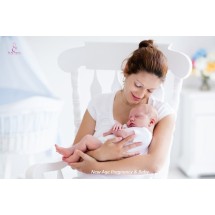 a) Face, Hair & Nails
a) Face, Hair & Nails
Brownish pigmentation might appear in the areas around the eyes, nose and cheeks which are called chloasma. Sun-exposure can cause these areas to darken further. They usually fade after delivery but are unlikely to completely disappear. Pregnancy hormones cause an increase in hair growth and many women will notice that their hair is thicker. Some might develop hair in areas that they do not normally have. All this will return to normal in the months after delivery. Some women might find that their nails grow faster during pregnancy while others might experience them breaking more easily. Whatever changes that occur during pregnancy are hormonal related and will resolve after delivery.
b) Skin & Stretch Marks
Skin changes are very common during pregnancy. However, if your skin is inflamed or blistered or have any irritation that lasts more than a couple of days, it is advisable to see your doctor.
Your skin retains more moisture during pregnancy and this tends to “plump” things up. You may appear to have a pinkish complexion due to the increased blood circulation and this can make you look flushed at times as well.
You might also notice a dark vertical line running from your belly button down to your pubic area. This is called the linea nigra and will fade after delivery.
Pregnancy can sometimes cause an aggravation of your eczema as the skin tends to be more sensitive during pregnancy. Acne can also increase due to the increased in sebum production. You might experience rashes or some temporary itchiness during your pregnancy and this will commonly resolve after birth.
However, if you have intense itching all over and especially on the palms of your hands and soles of your feet, this can be a sign of obstetric cholestasis, a rare liver disorder in pregnancy. This usually occurs in the 3rd trimester.
You might notice an increase in tiny red veins in your skin, this is due to the increase in the amount of blood in your body. Again, they will usually fade after birth.
Varicose Veins in your legs are due to the weight and pressure of the uterus leading to slow blood return from the lower body causing the veins in your legs to be engorged and swollen. They can also appear at the vagina and rectum (haemorrhoids). Most of the time, they do not cause any problems.
By Dr Claudine Tan, Obstetrician and Gynaecologist at SBCC Women’s Clinic






